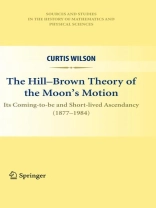The Hill–Brown theory of the Moon’s motion was constructed in the years from 1877 to 1908, and adopted as the basis for the lunar ephemerides in the nautical almanacs of the US, UK, Germany, France, and Spain beginning in 1923. At that time and for some decades afterward, it was the most accurate lunar theory ever constructed. Its accuracy was due, rst, to a novel choice of “intermediary orbit” or rst approxi- tion, more nearly closing in on the Moon’s actual motion than any elliptical orbit ever could, and secondly to the care and discernment and stick-to-it-ive-ness with which the further approximations (“perturbations” to this initial orbit) had been computed and assembled so as yield a nal theory approximating the Moon’s path in real space with an accuracy of a hundredth of an arc-second or better. The method by which the Hill–Brown lunar theory was developed held the potentiality for still greater accuracy. The intermediary orbit of the Hill–Brown theory may be described as a periodic solution of a simpli ed three-body problem, with numerical parameters carried to 15 decimal places. George William Hill, a young American mathematician working for the U. S. Nautical Almanac Of ce, had proposed it, and computed the numerical parameters to their 15 places. A self-effacing loner, he had in his privately pursued studies come to see that the contemporary attempts at predicting the Moon’s motion were guaranteed to fail in achieving a lunar ephemeris of the accuracy desired.
Table of Content
Hill Lays the Foundation (1877–1878).- George William Hill, Mathematician.- Lunar Theory from the 1740s to the 1870s – A Sketch.- Hill on the Motion of the Lunar Perigee.- Hill’s Variation Curve.- Early Assessments of Hill’s Lunar Theory.- Brown Completes the Theory (1892–1908), and Constructs Tables (1908–1919).- E. W. Brown, Celestial Mechanician.- First Papers and a Book.- Initiatives Inspired by John Couch Adams’ Papers.- Further Preliminaries to the Systematic Development.- Brown’s Lunar Treatise: Theory of the Motion of the Moon; Containing a New Calculation of the Expressions for the Coordinates of the Moon in Terms of the Time.- A Solution-Procedure Without Approximations.- The “Main Problem” Solved.- Correcting for the Idealizations: The Remaining Inequalities.- Direct Planetary Perturbations of the Moon (The Adams Prize Paper).- Indirect Planetary Perturbations of the Moon.- The Effect of the Figures of the Earth and Moon.- Perturbations of Order (?R)2.- The Tables.- Determining the Values of the Arbitrary Constants.- Ernest W. Brown as Theorist and Computer.- Revolutionary Developments in Time-Measurement, Computing, and Data-Collection.- Tidal Acceleration, Fluctuations, and the Earth’s Variable Rotation, to 1939.- The Quest for a Uniform Time: From Ephemeris Time to Atomic Time.- 1984: The Hill–Brown Theory is Replaced as the Basis of the Lunar Ephemerides.- The Mathematical and Philosophical Interest in an Analytic Solution of the Lunar Problem.
Language English ● Format PDF ● Pages 323 ● ISBN 9781441959379 ● File size 2.5 MB ● Publisher Springer New York ● City NY ● Country US ● Published 2010 ● Downloadable 24 months ● Currency EUR ● ID 2150133 ● Copy protection Social DRM












